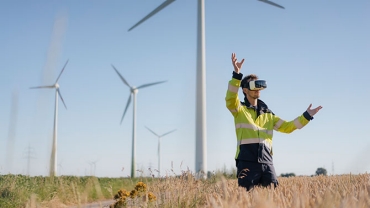
Net zero starts with robust ambition for emission reduction
30/11/21
From intention to concrete transformation
Prior to COP26, the United Nations climate conference in Glasgow, it was already clear that the world community would have to take major steps to achieve the Paris climate targets. The challenge applies not only to governments, but also to businesses. Many companies are on track to reduce CO2 emissions and at least as many are looking for a way to turn intentions into concrete transformation. PwC experts Karin Meijer and Taco Bosman explain how they support clients formulate their ambitions - the first building block in the practical guide ‘The building blocks for net zero transformation’.

Reducing five times more CO2
We need to reduce five times more CO2 than we are currently doing. That, in a nutshell, is the conclusion of the recently published PwC Net Zero Economy Index 2021. Karin Meijer is responsible for the climate change and net zero topics supporting clients in the energy sector, among others: 'Last year, we limited global CO2 emissions by 2.5%. But we will have to reduce them by 12.9 percent annually until 2030 in order to limit the temperature increase to 1.5 degrees Celsius, as agreed in the Paris climate accord.
Energy transition unavoidable
The transition from fossil to sustainable energy is unavoidable', says Taco Bosman. The question is not if, but when and how fast. He and Meijer work on climate issues in the special ESG team with around 65 colleagues, focussing on the manufacturing industry, retail, business service providers, pension funds and PE firms, among others. Apart from the climate necessity, it is a fact that fossil fuels are in short supply. They will run out or become too expensive to extract from the ground'. His explanation may sound obvious, but Bosman wants to say it out loud, as he often starts at the basis when talking to clients. 'The issue we discuss with clients is not so much whether the energy transition will take place, but when and how fast. Just look at David Attenborough's speech at COP26, which explains it in seven minutes.'
Ambition as a building block
What concrete steps can companies actually take? Microsoft asked PwC to develop a practical guide on: 'The building blocks for net zero transformation'. This publication discusses nine building blocks for achieving net zero CO2 emissions, with a checklist of critical actions and practical examples of companies that are leading the way. The first building block is determining ambition. According to Meijer, not every company has yet laid that foundation: 'We understand very well the emissions issue is a difficult one for many companies, which means some are already ahead on the road to net zero compared to others. Whatever the case, there is still plenty of work to be done.


Emission reduction in four steps
PwC supports clients achieve a robust emissions reduction ambition in four steps:
- Step 1: baseline
- Step 2: research-based targets
- Step 3: reduction plan
- Step 4: financial impact
Step 1: baseline
The first step is to determine the baseline: how many greenhouse gases does the company produce through its own activities and in the value chain? Bosman: 'Take a coffee producer for example. It emits CO2 by burning coffee beans and driving trucks, as well as heating their office buildings. Suppliers create emissions by applying fertiliser on the plantations and by using machines. And customers produce CO2 by heating water for making coffee. Each of these players have many more facets that create emissions. By calculating emissions for the entire chain we create transparency, according to the GHG (Greenhouse Gas) Protocol Corporate Standard'.
Step 2: research-based targets
Once the baseline has been determined, PwC can set research-based targets. That’s step two. Meijer: 'The Science Based Targets initiative (SBTi) has broken down the Paris targets by sector. Based on this scientific method, we can determine the emission reduction that each individual company must achieve in order to limit the global temperature increase to 1.5 degrees Celsius. In 2020, we had interactions with around 250 companies about this topic. Of this group, only 11% actually set a science-based target - an indication that there is still a lot of reduction to achieve. PwC as an organisation has a global ambition to be 'net zero' by 2030, with a science-based target of at least fifty per cent absolute emissions reduction.'
Step 3: reduction plan
As a step three, PwC provides support in drawing up a concrete action plan for achieving the reductions. Meijer: 'This could involve phasing out fossil fuels and lease cars, switching to renewable energy, reducing air travel and making all kinds of sector and company specific aspects more sustainable. Taking PwC as an example, we are striving for an entirely electric car fleet by 2025, all energy needed for our offices will come from renewable sources by 2022, and we are encouraging suppliers to be circular as well.
Step 4: financial impact
Step four is about calculating the financial impact and prioritising the actions in the plan. Bosman: 'Savings, investments, subsidy options and tax benefits are balanced against each other. Some emission reduction initiatives cost money, many have a positive business case. To give a simple example of the latter: reducing flights to foreign customers or colleagues is often a bigger financial saving than the investment needed for good digital meeting tools.

Environmental Footprint Insights
In addition to fundamental policy steps, organisations would do well to create awareness at an individual level of the impact of behavioural choices on CO2 emissions. With this in mind, PwC developed the Environmental Footprint Insights tool for use by its clients and its own employees. Bosman: 'Now, for every client project, I show what the PwC team's CO2 footprint will be. Do clients want to have regular physical meetings? If so, then this has consequences for the CO2 emissions resulting from travel. Want to collaborate digitally as much as possible? Then the emissions are lower.
Microsoft
Bosman refers to case studies of other companies in the publication - The building blocks for net zero transformation - for inspiration. Take Microsoft for example, who asked us to write up the publication. It was one of the first large organisations to say that it not only wants to be net zero, but even carbon negative by 2030. They also want to eliminate their own historical emissions from scope one and two by 2050 - which is quite a lot: emissions from their own operations and from energy consumption since the first start of the company. I also find it inspiring that Microsoft talks about climate opportunities instead of climate risks. For example, the company wants to bring CO2 accounting software to the market, helping other companies to reduce emissions'.
Careful optimism
For those who find the alarmist reports on climate discouraging, the science-based targets are a reason for careful optimism, Meijer thinks: 'Companies that use a science-based target are going to tackle their own emissions as well as those in the value chain. Take the coffee producer we mentioned earlier. The emissions of such a company in the value chain are 16 times greater than its direct emissions. Or take a semiconductor manufacturer - it produces up to 300 times its direct emissions in the value chain. And we are not even talking about the oil and gas industry. If more and more companies will start to also eliminate emissions in the value chain, the pace of emission reduction can accelerate exponentially. And that, as is now clear, is urgently needed.
Contact us


















